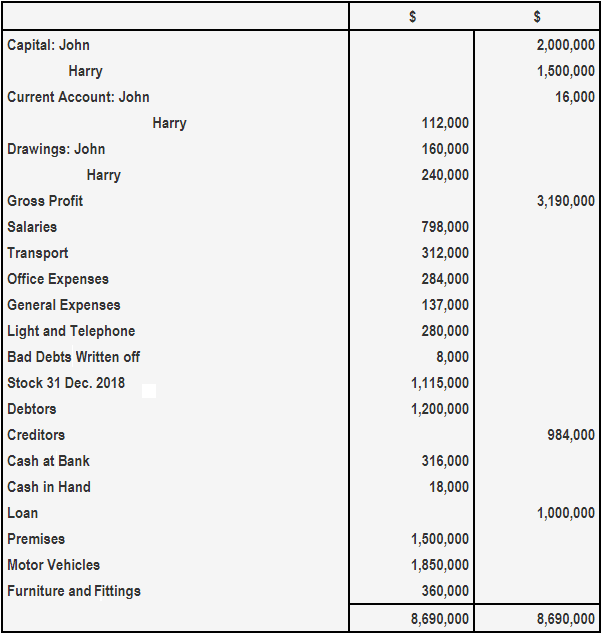Capital and Revenue Losses Sale of Asset or Merchandise

For the past 52 years, Harold Averkamp (CPA, MBA) has worked as an accounting supervisor, manager, consultant, university instructor, and innovator in teaching accounting online. In this case, it is considered an unrealized loss if you have not yet sold the asset, and so cannot be claimed as a tax deduction. Conversely, if you have incurred the loss by selling the asset, then you can claim a tax deduction on the amount of the loss.
Constructing loss and objective functions
As such, this report is sometimes called a statement of financial activities or a statement of support. Such proposals are concerned with changes in values of individual assets rather than with changes in the purchasing power of money which is reflected in the general price level. On the other side, the regulatory environment can directly contribute to financial losses in the form of fines and penalties. Regulatory bodies have the power to issue substantial penalties for non-compliance. These fines can vary drastically, but in some cases, they can be large enough to threaten a company’s financial stability. This introduces an element of unpredictability into the regulatory environment which could indirectly lead to financial losses.
Does a capital loss benefit from depreciation?
Compliance may require an upfront investment, but it can reduce uncertainty and protect against much larger potential losses in the future. Financial losses tied to these uncertainties, both market-related and specific to the business, are hard to accurately predict. However, understanding and continuously monitoring these forms of uncertainty can assist businesses and investors in mitigating potential losses. Appropriate financial planning and risk management strategies can act as valuable safeguards against the adverse impacts of uncertainty. The operation realm often hides potential loss areas, making it prime territory for loss mitigation. Efficient inventory management prevents overstocking or understocking, both of which can lead to financial losses.
Accounting terms

After accounting for every income and expense, including the “other” category, businesses arrive at a pre-tax figure. These expenses can be as varied as salaries, rent, and advertising costs. While they don’t have the direct impact of COGS, they’re crucial for business operations and often represent areas where cost-efficiencies can be introduced. The purpose of a P&L statement is to provide information about a company’s overall ability to generate profit, either by increasing revenue or decreasing costs, or both. Revenues and expenses for nonprofit organizations are generally tracked in a financial report called the statement of activities.
Cost of Goods Sold (COGS)
- Comparing one company’s P&L statement with another in the same industry that is similar in size can further help investors evaluate the financial well-being of a company.
- Investors and analysts can use this information to assess the profitability of the company, often combining this information with insights from the other two financial statements.
- An example of a capital loss is when an investment listed in the books at $48,000 is sold for $45,000; this leads to a capital loss of $3,000.
- Incurred losses refer to the value of losses that an insurance company incurs during a given period.
- Operating loss doesn’t take into account taxes or interest on loans, as these are considered to be outside the realm of a company’s typical business operations.
An incurred expense is a cost that a business incurs when it purchases goods or services on credit. The purchase may be made either through a credit card or a billing arrangement with the seller of the goods. Most companies buy raw materials in bulk from manufacturers and wholesalers on credit, with an agreement to pay at a later date. Incurred losses refer to the value of losses that an insurance company incurs during a given period. The losses represent the profits that the company will not earn during the year because the money is used to pay policyholders.
This format is the go-to for larger corporations and those keen on presenting a detailed picture to stakeholders. It sheds light on operational efficiency while also capturing the impact of peripheral activities. However, while its simplicity is admirable, it might not capture the nuance of different revenue sources and varied expenses. This format is often used by smaller businesses or for internal reviews where simplicity trumps detail.
It means that an accountant must recognize and record the transaction on the date when it occurred rather than on the date when the transaction was actually paid. The P&L statement offers invaluable insights into a business’s operations, efficiency, and potential areas for growth or improvement. After all deductions, jury duty pay is taxable including taxes, the remaining amount represents the company’s net profit. This is the money before the taxman takes his share, and it offers a clear picture of profitability from operations and secondary activities combined. It disregards anomalies or external factors, focusing only on the core business functions.
The effectiveness of insurance in mitigating losses depends on the appropriateness of the coverage. Companies must assess their risk exposure and select policies that align with their specific vulnerabilities. This might involve a combination of general liability, professional liability, and product liability insurance, among others.
This may disappoint income-seeking investors who rely on regular dividend payouts. While not all losses necessarily spell doom and gloom for shareholders, substantial and sustained losses are a cause for concern. If the actual losses exceed the reserve, the insurer will be required to get additional funds to top up the reserve. The change in the reserve amount will be a loss to the company because it was not anticipated.

Commenti recenti